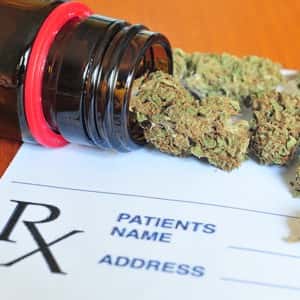
Two of our most complicated and challenging health problems are nerve pain and dementia. The drugs we have are often woefully inadequate. That’s why it is so intriguing to learn that ingredients in medical marijuana may be helpful against neuropathic pain and might also reduce the risk of Alzheimer’s disease.
Medical Marijuana Has a Long History:
Most physicians are puzzled by the very concept of medical marijuana. In medical school they often learn about marijuana only in the context of drugs of abuse. They may hear that this herb is dangerous and potentially addictive.
Needless to say, such a message has made doctors skeptical about the potential therapeutic uses of this ancient plant. That said, marijuana (Cannabis sativa) has a very long history. More than 4,000 years ago, Chinese healers recommended tea made from marijuana to treat gout and arthritis as well as malaria and intestinal parasites.
In India, a concoction of marijuana buds, leaves, milk, clarified butter and spices was used to ease anxiety and improve appetite and digestion, among other uses. The ancient Egyptians appear to have used cannabis to treat inflammation, hemorrhoids and sore eyes.
A Neolithic grave in the Netherlands dating from the second millennium BCE contained a large amount of pollen, primarily cannabis and meadowsweet. Presumably these plants had been used medicinally before the person buried there passed away.
Doctors Used to Prescribe Medical Marijuana:
The plant was used medicinally throughout the Middle East and even in Europe during the Middle Ages. Early settlers to America brought marijuana seeds with them to produce hemp in the 17th century. The fiber from the plant was used to make rope and fabric.
Marijuana was not widely used medicinally in the United States until the 19th century, when it was included in a number of patent medicine formulas. By 1854 cannabis was referenced in the U.S. Dispensary as a remedy for nerve pain, muscle spasms and depression. In 1870 the United States Pharmacopoeia listed cannabis as a medicine. Unproven claims for patent medicines (whether or not they contained marijuana) led the US to pass the Pure Food and Drug Act in 1906.
Marijuana (Reefer) Madness:
For much of the 20th century, marijuana was regulated primarily as a drug of abuse. In this climate, scientific research on medical marijuana was difficult, if not impossible. Federal research dollars were rarely allocated for seemingly marginal marijuana studies, unless they were likely to demonstrate harm.
New Research Shows Promise:
Really good placebo-controlled randomized trials of cannabinoids (compounds derived from marijuana) are not plentiful. Nonetheless, investigators have found that this plant contains a number of compounds with medicinal effects in humans. People being treated for cancer have found it helpful in overcoming the nausea, vomiting and lack of appetite triggered by chemotherapy (Annals of Medicine, May 2016). It also may ease pain, insomnia and depression in cancer patients.
Some anesthesiologists are finding that cannabinoids may be effective for managing chronic pain unrelated to cancer (Canadian Journal of Anesthesia, May, 2016). People with multiple sclerosis and the doctors who take care of them have noted that cannabis-based medicines such as Sativex reduce muscle spasms and help control neuropathic pain (Neuropharmacology, online Apr. 11, 2016). Multiple sclerosis patients often have trouble with bladder symptoms, and these too may be eased by medical marijuana (Nature Reviews. Urology, online July 5, 2016).
Medical Marijuana Against Alzheimer’s?
New research suggests that cannabinoids could also help reduce the inflammation in neurons that leads to Alzheimer disease (Nature: Aging and Mechanisms of Disease, online June 23, 2016). You can read more about the latest research at this link.
Readers’ Stories:
Marie in West Virginia shares:
“I took prescribed medication that made me have anxiety and suicidal thoughts. I also developed cognitive decline to the point that they thought I was getting Alzheimer’s disease. The only thing that helped me was a small bit of cannabis that I occasionally smoked.
“Then I would have to listen to the doctor tell me that all my memory problems were because of smoking that little bit and not because of the medication that I was on. I knew without a doubt it was related to prescribed medication. He refused to listen to me. Pharmaceutical drugs were causing the problems, not cannabis.
“I wish doctors were more educated and kept up-to-date on things and not peddled drug reps. Side effects and withdrawal from the pharmaceutical drugs took 7 years of my life . Cannabis has no withdrawal and it doesn’t make you suicidal.”
Sharon in Portland, Oregon offers this perspective on cannabidiol oil:
“My 27-year-old grandson has had epilepsy since he was 4 years old. He has a battery-operated device planted in his chest, and a wire going up the side of his neck and into his brain to make his seizures less severe. (Some of his seizures last 45 minutes or more.)
“He has spent a lot of time in the emergency room over the years. In the past 6 months or so he has been taking prescribed marijuana oil (under his tongue, I think) and his runs to the emergency room are now maybe once a month instead of twice a week. The family is very pleased with the outcome of using medical marijuana oil.”
A Balanced Perspective on Medical Marijuana:
Like other drugs, derivatives of marijuana have side effects as well as benefits. If you are interested in learning more about both the possible uses and the potential hazards of medical marijuana, you may wish to listen to our interview with David Casarett, MD, author of Stoned: A Doctor’s Case for Medical Marijuana. You can find this hour-long interview (show #1027) in the Radio Shows section of PeoplesPharmacy.com. Here is a link.

